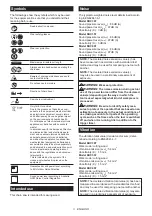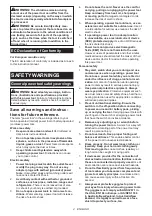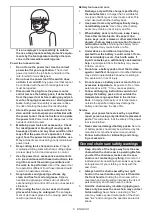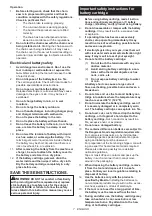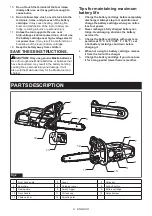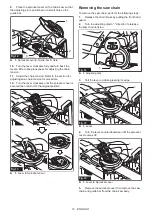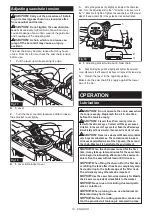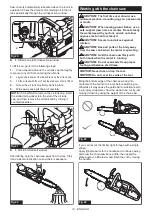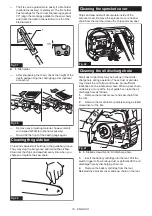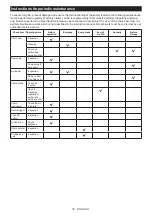
16 ENGLISH
•
Any person involved has an unhindered path
of retreat through a range of approximately
45° either side of the felling axis. Consider
the additional risk of tripping over electrical
cables;
•
The base of the trunk is free of foreign
objects, roots and ranches;
•
No persons or objects are present over a
distance of 2 1/2 tree lengths in the direction
in which the tree will fall.
— Consider the following with respect to each tree:
•
Direction of lean;
•
Loose or dry branches;
•
Height of the tree;
•
Natural overhang;
•
Whether or not the tree is rotten.
— Consider the wind speed and direction. Do not
carry out felling work if the wind is gusting strongly.
— Trimming of root swellings: Begin with the largest swell-
ings. Make the vertical cut first, then the horizontal cut.
— Stand to the side of the falling tree. Keep an area
clear to the rear of the falling tree up to an angle of
45° either side of the tree axis (refer to the “felling
area” figure). Pay attention to falling branches.
— An escape path should be planned and cleared
as necessary before cuts are started. The escape
path should extend back and diagonally to the rear
of the expected line of fall as illustrated in figure.
1
2
2
3
3
Fig.30
►
1.
Felling direction
2.
Danger zone
3.
Escape route
When felling trees, follow the procedures below:
1.
Cut a scarf as close to the ground as possible.
First make the horizontal cut to a depth of 1/5 -1/3 of the
trunk diameter. Do not make the scarf too large. Then
make the diagonal cut.
Fig.31
NOTE:
The scarf determines the direction in which
the tree will fall, and guides it. It is made on the side
towards which the tree is to fall.
2.
Make the back cut a little higher than the base
cut of the scarf. The back cut must be exactly horizon-
tal. Leave approximately 1/10 of the trunk diameter
between the back cut and the scarf. The wood fibers in
the uncut trunk portion act as a hinge. Insert wedges
into the back cut in time.
Fig.32
WARNING:
Do not cut right through the fibers
under any circumstances.
The tree will otherwise
fall unchecked.
NOTICE:
Only plastic or aluminum wedges may
be used to keep the back cut open. The use of
iron wedges is prohibited.
Carrying tool
Before carrying the tool, always apply the chain brake
and remove the battery cartridge from the tool. Then
attach the guide bar cover. Also cover the battery car-
tridge with the battery cover.
1
2
Fig.33
►
1.
Guide bar cover
2.
Battery cover


